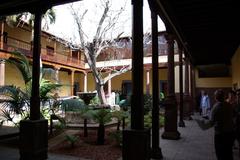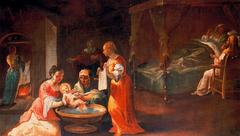Casona Estévanez-Borges: Visiting Hours, Tickets, and Historical Sites Guide – San Cristóbal de La Laguna
Date: 14/06/2025
Introduction: The Significance of Casona Estévanez-Borges
Nestled in San Cristóbal de La Laguna, Tenerife’s UNESCO World Heritage city, the Casona Estévanez-Borges stands as an enduring testament to Canarian architectural and cultural heritage. Built between the late 18th and early 19th centuries, this iconic manor house reflects the influence of distinguished families such as the Estévanez and Borges, both of whom were instrumental in shaping the island’s historical and intellectual fabric. The Casona’s architecture, characterized by its volcanic stone walls, Canary Island pine woodwork, and signature central courtyard, exemplifies the region’s adaptation of Spanish colonial design to local materials and climate.
Originally a private aristocratic residence, the Casona evolved into a vibrant center for intellectual gatherings and cultural events, and today is preserved as a Bien de Interés Cultural (BIC). Its restoration and adaptive reuse ensure that visitors can experience both its authentic historical features and its ongoing role as a living part of the community. Situated at 112 Avenida de Los Menceyes and easily accessible by tram and bus, the Casona is a gateway to the broader heritage of La Laguna, with major attractions such as the Cathedral, Plaza del Adelantado, and the Museum of History and Anthropology nearby (UNESCO; Patrimonio Histórico de Canarias; Ayuntamiento de La Laguna; Que Hacer en Tenerife; La Laguna Ahora).
Historical Overview
Origins and Ownership
Constructed during a period of economic prosperity, the Casona Estévanez-Borges epitomizes the grandeur of Canarian elite residences. Its earliest owners, the Estévanez family, were prominent figures in the island’s governance and society, frequently hosting cultural salons and political gatherings within the house. In the mid-19th century, the property transitioned to the Borges family through marriage, who continued its tradition of hospitality and initiated renovations that introduced neoclassical and eclectic elements.
Twentieth Century Adaptations
The decline of traditional agriculture and shifting urban dynamics in the 20th century led to the partial subdivision and adaptive reuse of the Casona, including rental for commercial spaces and apartments. Despite some alterations, the core structure and significant decorative features survived, aided by heritage recognition and restoration initiatives in the latter half of the century. The Bien de Interés Cultural (BIC) designation provided legal protection, ensuring careful conservation.
Modern Restoration and Public Role
In the 21st century, the building was restored with a focus on preserving original materials and was adapted for cultural and community uses. Managed under public oversight, the Casona now hosts exhibitions, educational workshops, and community events, with ongoing plans to serve as La Laguna’s first Casa de la Juventud, reinforcing its legacy as a hub for creativity and civic engagement (La Laguna Ahora).
Architectural Features and Conservation
Structure and Layout
The Casona is built in a U-shaped configuration, embracing a central cobbled patio—a hallmark of Canarian manorial architecture. Its walls of local volcanic stone provide both strength and climate control, while extensive pine woodwork is seen in balconies, eaves, and window frames. Noteworthy is the enclosed wooden balcony on the eastern façade, and the southern galleries that serve as sunrooms. The estate features outbuildings including historical stables and an artist’s studio, as well as a remarkable vaulted cistern (aljibe) for water storage (CICOP).
Decorative and Material Highlights
- Stone: Volcanic stone walls for durability and insulation.
- Wood: Canary Island pine for structural and decorative elements.
- Roofing: Curved clay tiles for efficient rainwater runoff and attic ventilation.
- Glazing: Hand-blown glass in upper galleries, a symbol of 18th-century luxury.
A mature almond tree, referenced in local poetry, graces the patio, while petroglyph-adorned basalt outcrops in the gardens highlight the site’s deeper historical significance (Que Hacer en Tenerife).
Conservation Efforts
Declared a BIC in 2010, the Casona has seen restoration focused on its external walls, galleries, and cistern, employing minimal intervention and reversible methods. Landscaping maintains the estate’s rural character, and updated utilities ensure continued use without compromising heritage (Arquitectura y Empresa).
Cultural Legacy and Intellectual Life
The Casona has long been a crucible for artistic and political discourse. Patricio Estévanez, a noted journalist, writer, and politician, led influential periodicals and social causes from this residence. The house was also home to the sculptor Francisco Borges Salas, whose works are celebrated both locally and internationally. Literary and intellectual gatherings (tertulias) hosted here attracted leading figures, including artists, poets, and visiting dignitaries (Que Hacer en Tenerife). The gardens’ ancient petroglyphs further tie the estate to Tenerife’s pre-Hispanic heritage.
Practical Visitor Information
Location and Access
- Address: 112 Avenida de Los Menceyes, Gracia, San Cristóbal de La Laguna, Tenerife.
- Public Transport: Direct access via the Gracia tram stop; well connected by local buses. The area is pedestrian-friendly, with nearby educational institutions and cultural sites (La Laguna Ahora).
- Parking: Limited in the historic center; public transport recommended.
Visiting Hours and Tickets
- Open: Tuesday to Sunday, 10:00 AM – 6:00 PM; closed Mondays and public holidays.
- Tickets: Generally free; some special events or guided tours may require a fee (typically €5 for non-residents, with discounts for students, seniors, and groups).
- Guided Tours: Available by advance booking; check with the Ayuntamiento de La Laguna for schedules and fees.
- Accessibility: Main floor and gardens are wheelchair accessible; some upper areas may have limited access due to historical architecture.
Amenities and Tips
- Best Time to Visit: Spring and autumn for mild weather and lighter crowds.
- Nearby Attractions: Cathedral of La Laguna, Plaza del Adelantado, Museum of History and Anthropology, and Calle de la Carrera.
- Special Events: Art exhibitions, workshops, and heritage celebrations—consult local tourism offices for current programming.
- Photography: Allowed in most areas; flash and tripods may be restricted to protect interiors.
Enhancing Your Visit: Walking Tour and City Highlights
San Cristóbal de La Laguna’s UNESCO-designated center is perfect for a walking tour. Begin at Plaza del Adelantado and explore heritage sites including Casa de Anchieta, Palacio de Nava, the Cathedral, and historic streets such as Calle de la Carrera and Calle de San Agustín. The city’s vibrant university atmosphere ensures a cosmopolitan cultural scene, while local cafes and taverns offer a taste of Canarian gastronomy (Web Tenerife).
Nature lovers can extend their visit to the Anaga mountain range or nearby Atlantic coast for hikes and scenic views.
Frequently Asked Questions (FAQ)
Q: Are tickets required to visit Casona Estévanez-Borges?
A: Entry is typically free, though some events or tours may require advance booking and a small fee. Confirm with the Ayuntamiento de La Laguna or local tourism office.
Q: What are the visiting hours?
A: Tuesday to Sunday, 10:00 AM – 6:00 PM; closed on Mondays and public holidays.
Q: Is the site accessible for visitors with disabilities?
A: The main floor and gardens are accessible; some upper areas may have limited access due to the historical building layout.
Q: Are guided tours available?
A: Yes, by appointment or as part of city-organized heritage routes.
Q: Can I take photographs inside the Casona?
A: Yes, except where otherwise indicated; flash and tripods may be restricted.
Key Visitor Information at a Glance
| Aspect | Details |
|---|---|
| Location | 112 Avenida de Los Menceyes, Gracia, San Cristóbal de La Laguna |
| Access | Tram (Gracia stop), local buses, pedestrian-friendly |
| Current Use | Heritage site; proposed Casa de la Juventud; check for public access and events |
| Visiting Hours | Tue–Sun, 10:00–18:00; closed Mondays and holidays |
| Tickets | Usually free; some events/tours may require a fee |
| Guided Tours | Available through city tourism office (Web Tenerife) |
| Nearby Attractions | University of La Laguna, Plaza del Adelantado, Cathedral, Calle de la Carrera |
| Accessibility | Main floor and gardens accessible; upper floors limited |
| Best Time to Visit | Spring or autumn; weekdays for a quieter experience |
Plan Your Visit and Stay Connected
For the latest details on opening hours, guided tours, and upcoming events, consult the Ayuntamiento de La Laguna or the local tourism office. Enhance your experience by downloading the Audiala app, which offers interactive maps, virtual tours, and insider tips for exploring La Laguna’s cultural heritage.
Explore more with these resources:
- UNESCO World Heritage: La Laguna
- Patrimonio Histórico de Canarias
- Que Hacer en Tenerife: Casa de Borges-Estévanez
- La Laguna Ahora: Casa de la Juventud
- Web Tenerife: La Laguna
Conclusion
The Casona Estévanez-Borges is a remarkable window into Tenerife’s storied past, blending architectural elegance, historical resonance, and vibrant cultural life. Its preservation and adaptive reuse reflect the commitment of La Laguna’s community to honoring its heritage while fostering innovation and engagement for future generations. Whether you’re drawn by history, architecture, or cultural exploration, a visit to the Casona offers a uniquely rewarding experience in the heart of the Canary Islands.

